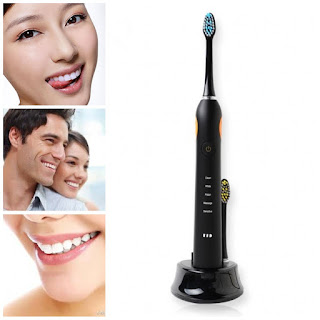
The advantage of a sonic brush is that it cleans teeth via two different methods. Beyond just conventional tooth scrubbing, it also creates a secondary cleansing action that helps to disrupt dental plaque beyond where the tips of its bristles actually touch. Only toothbrush designs that generate brush head speeds in the sonic range or above (e.g. ultrasonics) are able to make this latter claim.
By definition, a sonic toothbrush (yes, the word "sonic," as in sound) vibrates at a speed that lies within the range of frequencies that humans hear (20 to 20,000 hz).
As an example, full-power mode on a Sonicare toothbrush equates to 31,000 brush-strokes-per-minute.
At first glance, this number may seem higher than the range given above but it's not. The paragraph below explains the math.
[Frequency is measured in Hertz (hz) and it's units are cycles per second. One brush stroke (either up or down) equals 1/2 cycle, so the number above must be divided by 2. And then, of course, there are 60 seconds per minute, so the number above also needs to be divided by 60.]
The tooth-cleansing ability of any sonic toothbrush is due to two separate mechanisms.
Mechanical scrubbing. - Just like with other brushes, the biggest part of a sonic's ability to remove dental plaque is due to the action of its bristles as they scour the surface of the user's teeth.
The effectiveness of this type of cleansing generally has to do with the amplitude of the brush head (the distance, up or down, it travels on each stroke) and also its frequency (number of strokes per minute). Sonic toothbrushes characteristically are very efficient tooth scrubbers (see below).
Fluid dynamics. -This is considered only a secondary cleaning action but it's what makes sonic toothbrushes special.
Fluid dynamics refers to the process where the intense vibrational speed of the sonic brush's bristles agitate the fluids that surround the user's teeth (water, saliva), to the degree that they're able to disrupt dental plaque colonies even beyond where the bristles of the brush actually touch.
评论
发表评论